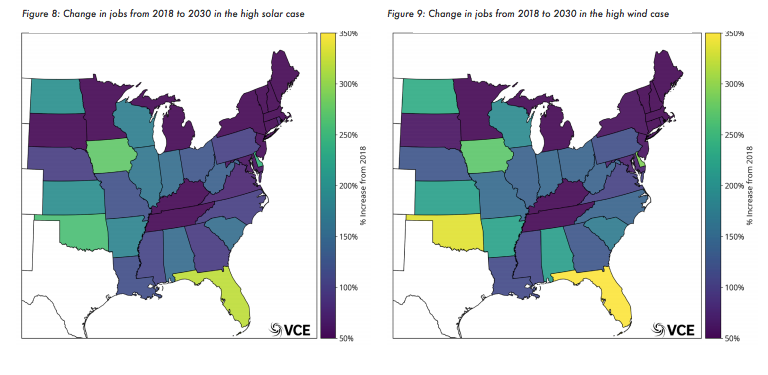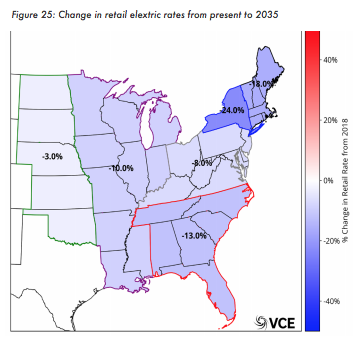As the costs of renewables continue to plummet, more states and utilities are committing to 100-percent clean energy goals. Still, they lack the capability to generate that inexpensive renewable electricity close to home. Meanwhile, other regions are occasionally so over-supplied with renewable energy (and faced with limited transmission capacity to meet demand elsewhere) that they have to curtail renewable generation or pay consumers to buy power. Expanding transmission networks would help connect regions with significant renewable resources to consumers and bring inexpensive power to a decarbonizing grid.
A new study written by Christopher Clack et. al of Vibrant Clean Energy LLC and Michael Goggin of Grid Strategies LLC shows that the benefits of adding transmission would be widely distributed. In the study, the authors analyze how to build grid transmission to achieve particular goals for reducing CO2 emissions and adding high amounts of wind or solar power to the Eastern Interconnect, the power grid that services most of the eastern United States. Within each of those scenarios, they can report changes in power generation, cost, and jobs. They find that adding transmission creates conditions for win-win-win scenarios for generating regions and consumers.
In their most ambitious scenarios, where emissions fall in line with the goals of the Paris Agreement, the eastern U.S. would require both solar from the southeast and wind from the midwest. The map below displays the transmission buildout required under the strong carbon policy for both the high solar (left) and high wind (right) scenarios. The high wind and high solar scenarios would require common transmission upgrades because of a convergence between wind and solar power generation capacity by 2050.

The authors conclude that investing in transmission to allow the entire eastern U.S. to access low-cost renewable energy in the Southeast and Midwest regions of the U.S. would reduce electric sector emissions by 95 percent by 2050, create more than 6 million new electric sector jobs, and save consumers roughly $105 billion through 2050, with these benefits spread across all states in the eastern U.S.
In terms of job creation, the 1 million net new jobs in the electric sector by 2030—and 6 million by 2050—are broadly spread out across the eastern United States. The maps below display net new jobs by 2030 for both the high solar and high wind deployment scenario, with every state experiencing an increase in net jobs, with the states in yellow experiencing a nearly 350 percent increase in energy sector jobs. These jobs would include building and maintaining transmission lines and manufacturing solar, wind, and storage resources.

By 2050, the average electric bill will have decreased from more than 9 cents/KWh today to roughly 6 cents/kWh, saving a typical household $300 per year. Despite an increase in the cost of transmission, which only accounts for 3.6 percent of a consumer’s total electric bills, consumers’ electricity bills should decrease because increased transmission provides consumers access to low-cost renewables, reducing the generation cost component that compromises more than two-thirds of consumers’ electric bills. The map below shows the change in retail electric rates from today to 2035, with every region experiencing a decline in average electric rates.

The findings of this study confirm that large-scale transmission expansion is a win-win for consumers, the environment, and the economy—and those benefits would accrue to all regions that the transmission network encompasses. Leaders of both the Democratic and Republican parties have expressed a willingness to rebuild American infrastructure. Still, policy shortcomings for how we plan, permit, and pay for inter-regional transmission networks must be addressed. The widespread environmental and economic benefits of investing in transmission infrastructure should be enough to garner bipartisan support to put forward policy solutions that allow for better planning, broader cost allocation, and streamlined permitting for transmission.
Photo by Rodolfo Clix from Pexels